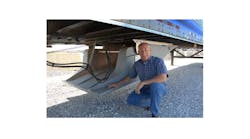Manager: Randy Cornell
Title: Vice president-maintenance
Fleet: Con-Way Truckload, Joplin, MO
Operation: Long-haul and regional freight service via 2,600 tractors and 8,000 trailers
Problem: Like many over-the-road fleets, Conway Truckload wanted to find ways to improve the aerodynamics of its 53-ft. dry van trailers in order to save on fuel. Yet while a bevy of different trailer aerodynamic devices offered the carrier ways to boost the fuel efficiency of its big rigs, concerns about how they impacted trailer maintenance loomed large as well.
“Instead of looking at the ‘utopia’ of test track fuel economy results, we try to take a look at things in the real world,” explains Randy Cornell, Con-way Truckload’s vice president-maintenance.
“In the real world, nothing is a perfect science; there are just way too many variables,” he says.
Take side skirts, for example. While they definitely reduce the drag created by moving a fully loaded trailer through the air, side skirts created other issues for the fleet—generated in part by their very design.
“Part of the challenge with skirts for us derives from pretrip inspections,” Cornell explains. “The side skirt blocks the view of the trailer’s underside. We need to be honest with ourselves; skirts mean drivers will need to get all the way down on the ground to inspect the trailer underside. They also hinder their ability to look at the fifth wheel.”
Solution: About two years ago, Con-way Truckload ended up selecting SmartTruck’s UT-6 Trailer UnderTray, a polyethylene plastic “wedge” attached to the underside of a trailer in front of the axles.
Greenville, SC-based SmartTruck says its testing determined the “wedge” alone offered a fuel-efficiency gain of at least 8.5%. Those gains jumped to 11% when the full UT-6 trailer system, which includes the wedge along with a separate plastic attachment in front of the under ride guard at the rear end of the trailer called a “diffuse,” and a “fin” running the width of the trailer’s top over the rear door was utilized.
From a maintenance perspective, Cornell liked other attributes of the UT-6 device. The plastic material of the wedge can survive the abuse of the road, such as de-icing chemicals, and is bolted to the trailer using weather-resistant galvanized hardware and fasteners. No special tools or equipment are needed to attach the unit either, and a full UT-6 system can be mounted on a trailer in as little as three hours, according to SmartTruck.
Yet the initial positioning and shape of the UT-6 system didn’t work as well as expected, Cornell says. After receiving and installing 125 of the devices, Con-Way Truckload went back to SmartTruck and requested some changes be made.
“The wedge itself used to be located very close to the rear axles, allowing for debris such as snow to build up in the gap,” he explains. “Also, the diffuser used to be mounted at the rear in a much more exposed position, so we had cases where drivers damaged them while backing into loading docks.”
SmartTruck went back to its laboratory with the feedback and performed some re-engineering, which included testing new locations for the various UT-6 components to ensure they provided the same aerodynamic benefits while eliminating the previous problems.
Now, the diffuser is located inboard of the trailer’s underride guard, protecting it completely. The wedge part of the UT-6 system was moved farther upstream from the trailer’s axles,with a long tapering wing helping it provide the expected aerodynamic improvement without being so close to the axle housing and wheels.
Since those changes 18 months ago, Con-way Truckload has installed 1,800 of the UT-6 UnderTray systems on its trailers, with zero dollars spent on maintenance, Cornell notes.
“And our drivers can still get under the trailer easily to conduct a proper pretrip inspection,” he points out. “That’s what really sold me on this.”



